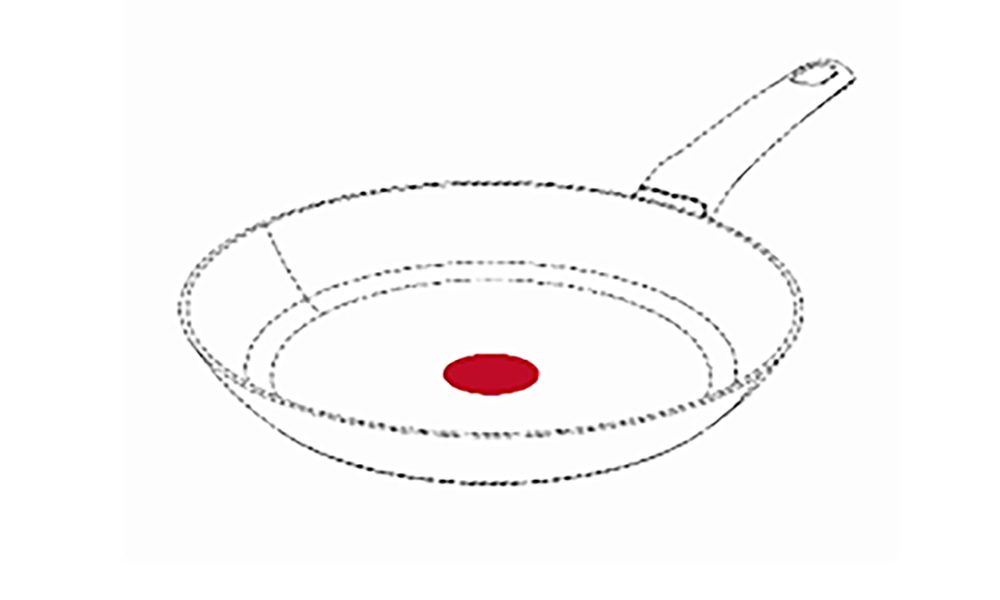Branding in Product Design – Finding Your Sweet Spot
Brands are all around us. Consumers will be familiar with brands associated with the names of companies and their products, and at the next level the logos, stylised fonts and colours that they use to present themselves in advertising or online usage.
But did you know that brands can also extend into designs applied to the products themselves? It is at this point that the law strikes a tricky balance between protecting valuable goodwill that may exist or be acquired through a particular trading style and not stifling competition by preventing competitors from using standard decorative (or functional) features. This was illustrated recently by the United Kingdom Intellectual Property Office's ( "UK IPO") decision on a UK application by Tefal to register their "red dot" mark (shown below) and described as "a plain red dot affixed centrally to the bottom of a cooking receptacle (such as a pan, saucepan)".

The main question that the UK IPO considers when examining such an application is whether the mark is "distinctive" /does it perform a source of origin function when viewed by the average consumer of the goods? This is a particular issue for decorative or "positional" marks which are likely to be viewed as having decorative and/or functional significance as well.
In many cases, the feature that is being claimed as a trade mark is not particularly remarkable. As a result, most applications for such "position" or "feature" marks encounter an initial objection of lack of distinctiveness, as happened for Tefal's application. However, this objection can be overcome if the applicant can show that the mark has "acquired distinctiveness through use i.e. that consumers would actually recognise the mark as an indicator of origin of the goods).
Depending on the type of mark it is possible to demonstrate acquired distinctiveness by reference to the nature and extent of the use of the mark through the submission of sales figures of products bearing the mark and details of advertising expenditure, sample advertising featuring the mark and examples of third party recognition of the mark (for example on third party websites or in press articles). However, for marks which are inherently less distinctive, stronger evidence of acquired distinctiveness may be required. This was the case for Tefal; whilst they could easily demonstrate substantial use of the mark (the figures for sales and advertising were large, and the total market share in the relevant market was substantial), merely exposing consumers to the mark was not considered sufficient to educate the consumers that this was a symbol of origin. Indeed Tefal's own case was undermined by the fact that the extensive advertising referred to and/or demonstrated that the "Famous Red Spot" was not an indicator of the product coming from Tefal, but an indicator of the product being hot.
To counter this, Tefal also provided survey evidence which purported to demonstrate consumer recognition of the mark. In theory, evidence from a consumer survey about recognition of the mark ought to be the ideal route to demonstrate acquired distinctiveness. However, survey evidence is not often relied on in the UK (it is more commonly used in other EU countries) because a) it can be very hard to frame the survey questions to elicit the appropriate answers without posing leading questions, b) there are always concerns over how representative the sampling is (surveys conducted on a large scale can be extremely time-consuming and expensive); and, related to b), c) it can be very hard to determine what an appropriate threshold for consumer recognition is.
Tefal's survey evidence exemplified this. The survey showed relatively high initial recognition of the mark by 32.5% of respondents, which was acknowledged to be statistically significant. Unfortunately, many of the respondents followed up by identifying the red dot as a "heat spot" or similar thus demonstrating an appreciation of its technical function rather than its branding function. The survey was also criticised for containing a leading question in the form of the key question of whether the respondent would identify the mark as indicating a product from a particular company.
Therefore, whilst it is far from impossible to register designs applied to products as trade marks, care should be taken as to how this marking is presented to the consumer and the ways in which advertising is used to "educate" consumers that the design is an indicator of the origin of the products. This may require deliberately down-playing any technical or functional characteristics of the design. Given that most marks of this type will require substantial use before they stand a chance of meeting the hurdles of acquired distinctiveness, it may be best to start this education process as soon as possible after the design is adopted.
